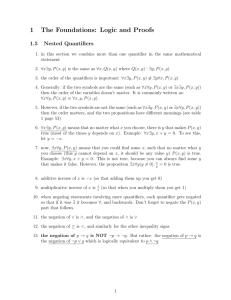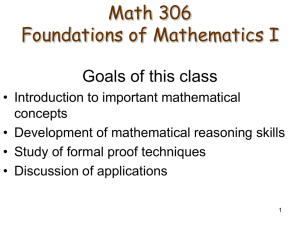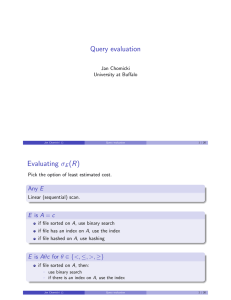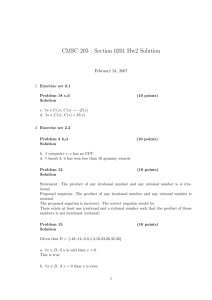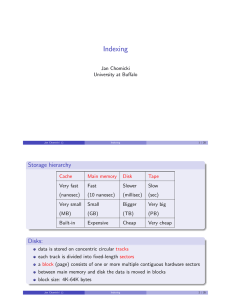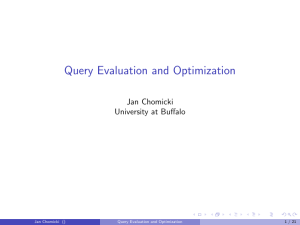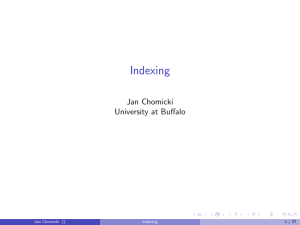Data Integration: Negation Open vs. Closed World Assumption Closed World Assumption ( )
advertisement
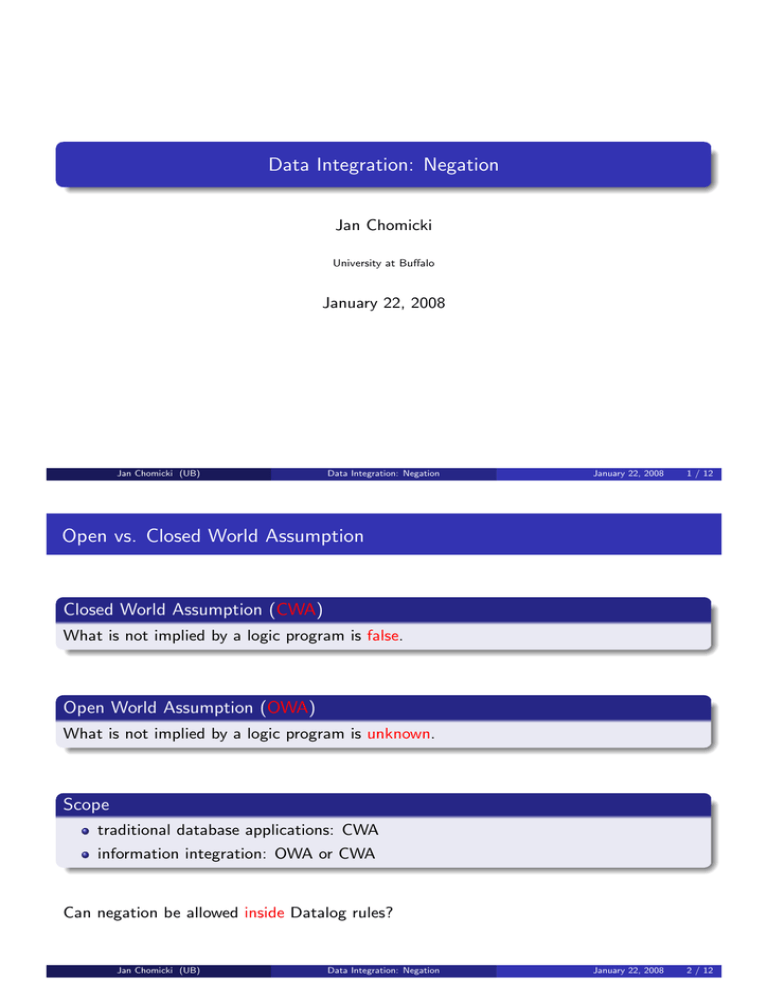
Data Integration: Negation
Jan Chomicki
University at Buffalo
January 22, 2008
Jan Chomicki (UB)
Data Integration: Negation
January 22, 2008
1 / 12
January 22, 2008
2 / 12
Open vs. Closed World Assumption
Closed World Assumption (CWA)
What is not implied by a logic program is false.
Open World Assumption (OWA)
What is not implied by a logic program is unknown.
Scope
traditional database applications: CWA
information integration: OWA or CWA
Can negation be allowed inside Datalog rules?
Jan Chomicki (UB)
Data Integration: Negation
Datalognot
Syntax
Rules with negated goals in the body:
A0 : −A1 , . . . , Ak , not B1 , . . . , not Bm .
Example
forebear(X,Y):-anc(X,Y), not parent(X,Y).
Generalizing TP
TP (I )
=
{A | ∃r ∈ ground(P). r = A : −A1 , . . . , An , not B1 , . . . , not Bm
∧A1 ∈ I ∧ · · · An ∈ I ∧ B1 6∈ I ∧ · · · Bm 6∈ I }
Jan Chomicki (UB)
Data Integration: Negation
January 22, 2008
3 / 12
January 22, 2008
4 / 12
Datalognot : semantics
Semantics
minimal (Herbrand) models:
one or more
the right one?
minimal fixpoints of TP :
none, one, or more than one
the right one?
bottom-up evaluation
Solutions
restrict programs syntactically: stratified,...
consider multiple logical meanings: stable models,...
Jan Chomicki (UB)
Data Integration: Negation
Stratification [ABW88]
Dependency graph pdg (P)
vertices: predicates of a Datalognot program P
edges:
a positive edge (p, q) if there is a clause in P in which q appears in a positive goal in
the body and p appears in the head
a negative edge (p, q) if there is a clause in P in which q appears in a negative goal in
the body and p appears in the head
Stratified P
No cycle in pdg (P) contains a negative edge.
Stratification
Mapping s from the set of predicates in P to nonnegative integers such that:
1
if a positive edge (p, q) is in pdg (P), then s(p) ≥ s(q)
2
if a negative edge (p, q) is in pdg (P), then s(p) > s(q)
There is a polynomial-time algorithm to determine whether a program is stratified, and
if it is, to find a stratification for it.
Jan Chomicki (UB)
Data Integration: Negation
January 22, 2008
5 / 12
Stratified Datalognot : query evaluation
Bottom-up evaluation
1
2
compute a stratification of a program P
partition P into P1 , . . . , Pn such that
each Pi consisting of all and only rules whose head belongs to a single stratum
P1 is the lowest stratum
3
evaluate bottom-up P1 , . . . , Pn (in that order).
Result
does not depend on the stratification
can be semantically characterized in various ways: minimal, perfect...
is used to compute query results (like MP )
Jan Chomicki (UB)
Data Integration: Negation
January 22, 2008
6 / 12
Expressiveness
Query equivalence
Two queries are equivalent if their semantics defines the same mapping from input
databases to output results.
Query language containment
L1 ⊆ L2 if for every query Q1 ∈ L1 , there is an equivalent query Q2 in L2 .
Expressiveness
Relational Algebra ⊆ Stratified Datalognot
Datalog 6⊆ Relational Algebra
transitive closure
Relational Algebra 6⊆ Datalog
set difference
Jan Chomicki (UB)
Data Integration: Negation
January 22, 2008
7 / 12
January 22, 2008
8 / 12
Computational complexity
Decision problem
Is a tuple t in the result Q(D) of a query Q applied to a database D?
Data complexity [Var82]
Complexity as a function of the cardinality of the database D:
fixed: database schema, query Q
input: database D
Combined complexity
Nothing considered fixed.
Theorem
Data complexity of Stratified Datalognot queries is in PTIME.
Jan Chomicki (UB)
Data Integration: Negation
Stable model semantics [GL88]
M a subset of the Herbrand base of a Datalognot program P.
Reduct PgM
Obtained from ground(P) by the Gelfond-Lifschitz transform:
for every A ∈ M: remove every clause that contains not A in the body
for every A 6∈ M: remove not A from the body of every clause in which it appears.
Stable model
M is a stable model of P if M is the least (Herbrand) model of the reduct PgM .
Properties of stable models
a program can have zero, one, or more stable models
a stratified program has a single stable model computed by bottom-up evaluation.
Jan Chomicki (UB)
Data Integration: Negation
January 22, 2008
9 / 12
Encoding propositional satisfiability [MT99]
Given a CNF formula φ with the set of clauses C and the set of propositional variables V .
Set of facts Eφ
var(a) for every a ∈ V
clause(c) for every c ∈ C
pos(c, v ) if v occurs positively in c
neg(c, v ) if v occurs negatively in c
Generating all possible truth assignments
(SAT1)
(SAT2)
true(X):- var(X), not false(X).
false(X):- var(X), not true(X).
Clause satisfaction
(SAT3)
(SAT4)
(SAT5)
sat(C):- var(X), clause(C), true(X), pos(C,X).
sat(C):- var(X), clause(C), false(X), neg(C,X).
f:- clause(C), not sat(C), not f.
Jan Chomicki (UB)
Data Integration: Negation
January 22, 2008
10 / 12
Fact
M is a stable model of the program consisting of Eφ and (SAT1)-(SAT5) iff M contains
exactly the following facts for some U ⊆ V :
Eφ
sat(c) for every c ∈ C
true(v ) for every v ∈ U
false(v ) for every v ∈ V − U.
Corollary
Data complexity of checking the existence of a stable model of a Datalognot program is
NP-complete.
Jan Chomicki (UB)
Data Integration: Negation
January 22, 2008
11 / 12
Querying using stable models
Query answer
A tuple t is a cautious query answer if query(t) belongs to every stable model of P.
Theorem
Data complexity of computing cautious answers to Datalognot queries is co-NP-complete.
Jan Chomicki (UB)
Data Integration: Negation
January 22, 2008
12 / 12
K. R. Apt, H. A. Blair, and A. Walker.
Towards a Theory of Declarative Knowledge.
In J. Minker, editor, Foundations of Deductive Databases and Logic Programming,
pages 89–148. Morgan Kaufmann Publishers, 1988.
M. Gelfond and V. Lifschitz.
The Stable Model Semantics for Logic Programming.
In ICLP/SLP, 1988.
V. W. Marek and M. Truszczynski.
Stable logic programming – an alternative logic programming paradigm.
In K. R. Apt, V. W. Marek, M. Truszczynski, and D. S. Warren, editors, The Logic
Programming Paradigm: A 25-Year Perspective. Springer-Verlag, 1999.
Also: CoRR cs.LO/9809032.
M. Y. Vardi.
The Complexity of Relational Query Languages.
In ACM Symposium on Theory of Computing (STOC), pages 137–146, 1982.
Jan Chomicki (UB)
Data Integration: Negation
January 22, 2008
12 / 12



